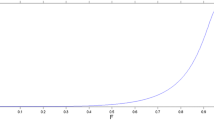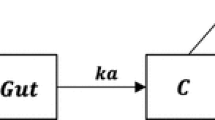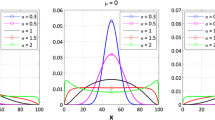Abstract
Pharmacokinetic analysis in humans using compartmental models is restricted with respect to the estimation of parameter values. This is because the experimenter usually is only able to apply inputs and observations in a very small number of compartments in the system. This has implications for the structural identifiability of such systems and consequently limits the complexity and mechanistic relevance of the models that may be applied to such experiments. A number of strategies are presented whereby models are rendered globally identifiable by considering a series of experiments in parallel. Examples are taken from the pharmacokinetic literature and analysed using this parallel experiment methodology. It is concluded that considering a series of pharmacokinetic experiments where some, but not all, of the parameters may be shared across the experiments can improve the identifiability of some compartmental models.





Similar content being viewed by others
Notes
Partitions the set of all possible parameter values into classes that give the same observed behaviour.
References
Wagner JG (1993) Pharmacokinetics for the pharmaceutical scientist. Technomic Publishing Company Inc., Pennsylvania
Bellman R, Astrom KJ (1970) On structural identifiability. Math Biosci 7:329–339
Anderson DH (1983) Compartmental modelling and tracer kinetics. Springer-Verlag, Berlin
Saccomani MP, Cobelli C (1993) A minimal input output configuration for a priori identifiability for a compartmental model of leucine metabolism. IEEE Trans Biomed Eng 40:797–803
Moghadamnia AA, Rostami-Hodjegan A, Abdul-Manap R, Wright CE, Morice AH, Tucker GT (2003) Physiologically based modelling of inhibition of metabolism and assessment of the relative potency of drug and metabolite: dextromethorphan vs. dextrorphan using quinidine inhibition. Br J Clin Pharmacol 56:57–67
Nelson E, Schaldemose I (1959) Urinary excretion kinetics for evaluation of drug absorption I. J Am Pharm Assoc 48:489–495
Evans ND, Chappell MJ, Chapman MJ, Godfrey KR (2002) Identifiability of uncontrolled rational systems. Automatica 38:1799–1805
Walter E (1982) Identifiability of state space models. Springer-Verlag, New York
Vajda S, Rabitz H (1989). State isomorphism approach to global identifiability of nonlinear systems, IEEE Transactions on Automatic control. AC-34: 220–223
Cobelli C, Romanin-Jacur G (1976) Controllability, observability and structural identifiability of multi input and multi output biological compartmental systems. IEEE Trans Biomed Eng 23(2):93–100
Sontag E (1990) Mathematical control theory: deterministic finite dimensional systems. Springer-Verlag, New York
Godfrey KR, Chapman MJ (1990) Identifiability and indistinguishability of linear compartmental models. Math Comput Simul 32:273–295
Godfrey KR, Jones RP, Brown RF (1980) Identfiable pharmacokinetic models: The role of extra inputs and measurements. J Pharmacokinet Biopharmaceutics 8:633–648
Yuasa H, Matsuda K, Watanabe J (1995) Influence of anesthetic regimens on the intestinal absorption of 5-Fluorouracil in rats. Biol Pharm Bull 18:747–752
Brown M, Bjorksten A, Medved I, McKenna M (2004) Pharmacokinetics of intravenous N-acetylcysteine in men at rest and during exercise. Eur J Clin Pharmacol 60:717–723
Acknowledgments
The authors would like to thank Amin Rostami and Mats Karlsson for useful discussions about these models.
Author information
Authors and Affiliations
Corresponding author
Rights and permissions
About this article
Cite this article
Cheung, S.Y.A., Yates, J.W.T. & Aarons, L. The design and analysis of parallel experiments to produce structurally identifiable models. J Pharmacokinet Pharmacodyn 40, 93–100 (2013). https://doi.org/10.1007/s10928-012-9291-z
Received:
Accepted:
Published:
Issue Date:
DOI: https://doi.org/10.1007/s10928-012-9291-z




